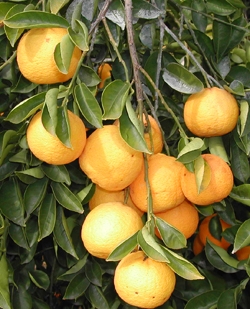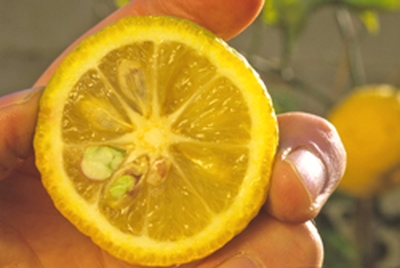|
|||||||||||
| |
Select any of 50
available languages! |
||||||||||
Papedas
and other small sour citrus types
 |
Subgenus Papeda Primitive citrus types Uses Ichang papeda Citrus cavaleriei Ichang lemon 'Shangyuan' Ichandarin 'Liudmila' Sudachi papeda Citrus sudachi Yuzu Citrus × junos Yuko Citrus yuko Khasi
papeda Citrus latipes
Small-flowered papeda 'Biasong' Citrus micrantha Small-fruited papeda 'Samuyao' C. m. var. microcarpa Celebes papeda Citrus celebica |
| Ichandarin
'Liudmila' © Jorma Koskinen |
|
Subgenus
Papeda
Papedas form a subgenus of the genus Citrus. They are a group of acid wild citrus types growing in the monsoon region and parts of Japan and China. Papedas have pulp vesicules with numerous droplets of acrid oil, which makes many of them inedible. The petioles are always large and broadly winged. They are very long, 1,5 - 3 times longer than broad. Melanesian papeda Citrus macroptera can have petioles almost as wide and half of the length of the main leaf. The petioles of the Celebes papeda Citrus celebica can be larger than the blade in fully grown trees. Ichang papeda Citrus cavaleriei is the most cold-resistant of all the evergreen species in the citrus subfamily. Only the deciduous Trifoliate orange Citrus trifoliata is hardier. Primitive
citrus types
Papedas belong to the oldest and most primitive known citrus types and
according to recent
studies have contributed their genes to many well-known citrus fruits,
most notably the various kinds of limes. Citrus micrantha,
the Small-flowered papeda or Biasong,
is one of the parents of the common lime
(Key lime), Citrus
aurantiifolia.
(See Introduction, The
genus Citrus). The
species of the subgenus Papeda
have been shown to possess decidedly
simpler flowers than the species of the genus Citrus. The
Papedas C. micrantha,
celebica, macroptera and hystrix
have small flowers, 1.2 to 1.7 (rarely 2) cm in diameter. The
discovery of a primitive character in the papedas serves to emphasize
how very
different they are from the true oranges of the genus Citrus.
Uses
Some
papedas yield fragrant aromatic oil, which can be used
in perfumery. Malays, Melanesians and Polynesians have used papeda
juice as a hair wash and added it to
coconut oil for fragrance. Goldsmiths have used papedas to clean
gold objects. Papeda fruit are used in native medicines and Ichang
papeda Citrus
cavaleriei is used in traditional Chinese medicine. Many
papedas occur only in the wild, but the Small-flowered papeda Citrus micrantha is
cultivated in the Philippines. The two hybrids of the Ichang papeda, Yuzu and the
Ichang lemon are cultivated in China, Japan and many countries
of the Far-East. The leaves and rind of the Kaffir lime a.k.a.
Mauritius
papeda Citrus
hystrix have many food uses and the plant is cultivated in
most citrus growing regions around the world. |
| LAT | Citrus
cavaleriei H. Lév. ex
Cavalerie (Bull. Géogr.
Bot. 21:112. 1911) Ichang papeda |
  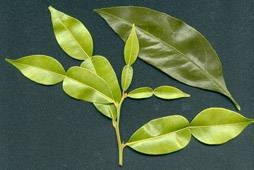 |
| Syn |
Citrus ichangensis Swingle 1913 Citrus hongheensis Y.Ye, X.Liu, S.Ding & M.Liang 1976 Citrus macrosperma T.C. Guo & Y.M. Ye 1997 |
|
The Ichang papeda is a slow-growing species of the genus Citrus, which has characteristic lemon-scented foliage and flowers. It is native to East Asia and China's Hubei province. The Ichang papeda's main claim to fame is its unusual hardiness. With the exception of the Trifoliate orange Citrus trifoliata it is the hardiest citrus plant, tolerating both moderate frost and damp conditions. For this reason, it is perhaps the only species of true citrus which can be reliably grown outside in the temperate areas of Europe and the United States. It is a member of the Papeda subgenus of citrus. Other members of the subgenus include the Kaffir Lime which is used in oriental cuisines. This plant, which grows in a wild state in central and southwestern China, is doubtless the most cold-resistant of all the evergreen species in the orange subfamily. It differs greatly from the other species in the subgenus Papeda in having large flowers, and large, very thick seeds. The leaves also differ in having extremely long but rather narrow winged petioles, often exceeding in area the slender, pointed, lanceolate leaf blades. Bottom picture taken by Mike Saalfeld shows Ichang papeda and a clementine leaf. There are many hybrids of the Ichang papeda. The Ichang lemon (below) in spite of its name is a hybrid of the Ichang papeda and a pomelo. Hybrids of the Ichang papeda and mandarin are called Ichandarins. The first man-made Ichandarin was a hybrid of the Ichang papeda and a satsuma mandarin. 'Liudmila' is an Ichandarin variety. Below is a description of two more Ichandarins Sudachi and Yuzu, both hybrids of the Ichang papeda and the sour mandarin Citrus sunki. |
||
| ENG | Ichang papeda, Ichang lime | |
| FRA | Papeda Ichang, | |
| Photos | © UC-Riverside Citrus Collection (3) © Home Citrus Growers | |
| Link | ||
| LAT | Ichang lemon 'Shangyuan' |  |
| Syn | Citrus cavaleriei × Citrus maxima Citrus wilsonii Tanaka |
|
Contrary to common belief the Ichang lemon is not a synonym of the Ichang papeda but its hybrid with a pomelo and should properly be called Ichang pomelo. It is also called Shangyuan and is widely grown and used in China to perfume rooms and cabinets. In the US it has been used for lemon pie and the connoisseurs who have used Shangyuan prefer it to regular lemon pies. It is very resistant to winter cold and the rind oil has a strong flavour. The Chinese name Hsiang Yüan means "a fragrant ball." The 7-10 cm fruit are lemon yellow when ripe and often deeply furrowed. Shangyuan forms a small thorny tree and the leaves have large petioles. |
||
| ENG | Ichang lemon, Ichang pomelo, Shangjuan, Shangyan, Hsiang Yüan | |
| FRA | Citron
Ichang |
|
| Photo | © Jorma Koskinen | |
| LAT | Ichandarin 'Liudmila' |      |
| Syn | Citrus cavaleriei × Citrus unshiu Citrus wilsonii Tanaka |
|
Ichandarin is a man-made hybrid of the Ichang papeda and a mandarin. In the first crosses the mandarin was a satsuma. The Ichandarin in the pictures is a seedling. Because of the lack of petioles in the leaves it most likely is an unknown hybrid. The plant grows in the Gene Lester citrus collection in California and was named after a friend. It is a beautiful and productive ornamental with a dense shiny foliage of large leaves and plentiful fruit that hang singly or in clusters of 3 to 9. The flower buds show a hint of purple when quite immature but the flowers have no purple shade. This ichandarin is also unusual in that new growth is yellowish green. The friend who gave this plant to Gene says the peel is edible. It lacks the typical acrid oils of most papeda peels. The fruit and taste are quite similar to yuzu but whereas yuzu drops its fruit quite early the fruit of 'Liudmila' stay on for a long time. In the present writer's opinion it is an ideal compact citrus plant for the dooryard and perfect as a pure ornamental. |
||
| ENG | ||
| FRA | ||
| Photo | © Jorma Koskinen | |
| LAT | Citrus sudachi Hort. ex Shirai |    |
| Syn | Citrus cavaleriei × Citrus sunki |
|
Sudachi ichandarin (Sudachi papeda) is thought to be a hybrid of Ichang papeda (Citrus cavaleriei) and the sour mandadin (Citrus sunki). When used for cooking purposes, Sudachi is harvested while still green, which occurs during September to October, and are served in cut halves as a garnish. Growth is slow, may have dwarfing characteristics. Trees are long-lived. Sudachi is an acid citrus; it bears small fruit (20-25 g) and is traditionally grown in Tokushima Prefecture (Japan). Wikipedia has a short article on Sudachi. |
||
| ENG | Sudachi papeda, Sudachi Ichandarin | |
| FRA | Papeda Sudachi | |
| Photos | © Jorma Koskinen | |
| LAT | Citrus × junos Sieb. ex Tanaka Yuzu |    |
| Syn | Citrus cavaleriei × Citrus reticulata var. austera |
|
Yuzu was earlier classified as a valid species but study has shown it to be an Ichandarin, a hybrid of Ichang papeda (Citrus cavaleriei) and Sour mandarin (Citrus sunki) The fragrant yuzu lemon orginates from China, but is mostly grown in Japan where both the juice and the grated rind are used in traditional Japanese cooking. The aroma is pungent and the dried peel is used as a spice. The fruit is used in a ritualistic New Year ceremony to ensure good health. Wikipedia has a good article on Yuzy lemon describing its uses in Japanese and Korean cuisines. |
||
| ENG | Yuzu,
Yuzu ichandrin |
|
| FRA | Yuzu | |
| Photos | (1) ©
Jorma Koskinen (2-3) © Laaz |
|
| Links | ||
| LAT | Citrus yuko Hort. ex Tanaka | 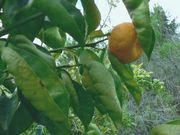 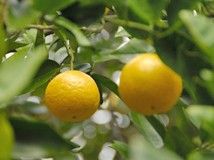   |
| Yuko is a frost hardy native Japanese citrus recently saved from extinction. "It was only recently that the yuko was rediscovered and recognized as an astringent citrus fruit native to Japan. In appearance the fruit resembles the yuzu (Citrus junos) and kabosu (C. sphaerocarpa). When it ripens, the outer rind and flesh turn a bright yellow that calls to mind the lemon. The yuko has many seeds, a sharp but well-rounded flavor, and juicy flesh; the white inner rind is also edible." "Yuko is used to add flavour to vinegared side dishes and to garnish fish including sardines. Children eat the fruit and drink its juice. The fruit has traditionally been floated in bathtubs for a fragrant bathing experience and used medicinally to treat the common cold and other ailments. Since the strains in use have come from naturally growing trees, rather than managed, cultivated ones, the fruit shows great diversity in the thickness of its rind, its size, and its flavour." "Beginning in the 1960s, the yuko began disappearing rapidly from the Nagasaki region. There were various reasons for this. First of all, farmers introducing satsuma oranges feared crosspollination would reduce the value of their new crops. Second, mass production of vinegar and other seasonings reduced the need for home-grown citrus fruit. Third, the trees got in the way of farmers' efforts to expand fields for vegetable production. And fourth, the yuko trees grew tall relatively quickly, making it difficult to harvest their fruit." "As of December 2007, there were a confirmed total of 116 yuko trees standing in the two producing districts, with 52 in Doinokubi and 64 in Sotome. It is hard to get accurate numbers for fruit yield per tree, but hearings carried out in the two districts indicate that each tree produces upwards of 500 yuko per season on average. Residents in both areas begin harvesting the fruit around September, when the skin is still green, for use in place of vinegar. In November the fruit takes on its yellow colour and is harvested and eaten fresh. Some yuko can score as high as 12 degrees on the Brix scale of sugar content, making them some of the sweetest astringent citrus fruit anywhere. The species is characterized by a particularly long harvest season, lasting from September through March. No pesticide is applied to the trees, so people can take bites through the rind and use the entire fruit, rind and all, without concern." The above excerpts are from an article "The Yuko, a Native Japanese Citrus" written by Yoko Kurokawa, published by The Tokyo Foundation and reproduced here by permission. |
||
| ENG | Yuko | |
| FRA | ||
| Photos | (1) © Gene
Lester (2-4) © Kazuo Kikuchi |
|
| LAT | Citrus micrantha Wester |   |
| Syn | Citrus marcoptera var. micrantha Wester |
|
The Small-flowered papeda (Biasong) stands out from all others of the subgenus Papeda because of its very small flowers, only 1.2-1.3 cm wide, white, with a trace of purple on the outside. The fruits are 5-7 cm long; surface fairly smooth or with transverse corrugations, lemon yellow; skin comparatively thick; pulp rather juicy, grayish, acid; aroma similar to that of samuyao; Seeds are numerous. The leaves have broadly ovate blades, blunt-pointed at both ends, 3.5-6 cm long, 2.7-4 cm wide with petioles 3,5 to 6 cm long, broadly winged, up to 4 cm wide; wing area sometimes exceeding leaf area. Seeds are numerous. The tree attains a height of 7.5 to 9 meters, with comparatively small but sharp spines. This species is cultivated in the southern Philippine Islands, especially Mindanao, where it is called biasong. The fruit was generally thought of as being inedible, but Ponchit Enrile from the Aseya Bistro in Davao City told me that it is a favourite flavouring for kinilaw (raw fish or seafood marinated with vinegar and limes) and Tom Yum Kung. The fruit can be bought in wet markets all over Mindanao and fetches high prices when not in season. When in season it would sell for 10 US cents a piece. Patrick Gozon's blog has an article on his search for the Biasong in Davao. |
||
| ENG | Biasong papeda, Small-flowered papeda, | |
| FRA | ||
| Photos | © Patrick Gozon | |
| LAT | Citrus micrantha var. microcarpa Wester | 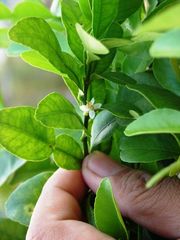  |
| Syn | Citrus westeri Tanaka |
|
The Small-fruited papeda, Samuyao, has the smallest fruit and the smallest flowers of any True Citrus Fruit Tree known but has more segments in the fruit (seven to nine) than Citrus micrantha (six to eight), although the fruits of the latter are much larger, 5 to 7 by 3 to 4 cm, instead of 1.5 to 2 cm, as in the variety microcarpa. Samuyao, endemic in Cebu and Bohol, is a shrubby tree, 4.5 meters tall, with slender branches and small, weak spines; leaves 55 to 80 millimeters long, 20 to 25 millimeters broad, thin, of distinct fragrance. Flowers 2 to 7, small, 5 to 9 millimeters in diameter, white, with trace of purple on the outside. Fruit 15 to 20 millimeters in diameter, roundish in outline; base sometimes nippled; apex an irregular, wrinkly cavity. Surface corrugate, greenish lemon yellow; oil cells usually sunken; skin very thin; pulp fairly juicy, acid, bitter with distinct aroma; juice cells very minute, blunt, containing a small greenish nucleus; seeds small, flattened, sometimes beaked. The fruits are not eaten but were used by goldsmiths to clean gold objects. They also enter into native medicines. The crushed fruits are used by the women of Cebu for cleansing the hair and are added to coconut oil to give it fragrance when applied to the hair. The tree bears within five years from planting and produces fruits during the entire year, but more abundantly during the rainy season. Patrick Gozon's blog has interesting entries on his search for the elusive Samuyao in Cebu. |
||
| ENG | Samuyao papeda, Small-fruited papeda | |
| FRA | ||
| Photos | © Patrick Gozon | |
| LAT | Citrus webberii Wester Kalpi papeda |     |
| Syn | ||
Kalpi papeda is a mandarin-like citrus fruit tree which was named C. webberii by Wester in honor of his former chief, H. J. Webber. It is called kalpi in the Bicolano dialect. Kalpi is a medium-sized, handsome tree 5 to 10 meters tall, bearing very juicy, acid fruits that can be used like lemons.It grows in both the large islands of the Philippines, Luzon and Mindanao. The fruit is variable in size, depressed-globose, with 9 to 11 segments; skin very thin, yellowish when ripe. It seems to be a hybrid of the native Citrus macroptera with the common Philippine mandarin, much like Yuzu. |
||
| ENG | Webber's Philippine hybrid, Alsem, Nogapog | |
| FRA | Papeda Kalpi | |
| Photos | (1-2) © Jorma Koskinen (3-4) © Gene Lester |
|
|
|
||
| LAT | Citrus hystrix DC. |       |
| Syn | Citrus torosa Blanco Papeda hystrix |
|
Kaffir lime is the strong spice used in Indonesian and Thai cooking. All parts of the plant are strongly aromatic. Especially the sometimes pungent aroma of the leaves is appreciated. Many consider the leaves of the Kaffir lime to have a stronger scent of citrus than lemon grass, but to retain the aroma, don't over boil. The zest can be used as well but the juice often has a bitter after taste. The leaves are gathered, several at a time, to form a tube-like shape . This tube is then turned to an angle (of 45 degrees) and cut with a sharp knife into very thin slices. Cut in this manner you will get longish thin stripes that can be added to food during cooking to release their aroma. Best results are obtained when some of the stripes are added at the start of cooking, some when the liquid is added and the rest only a few minutes before the dish is done. In the tropics Kaffir lime is often sold still attached to a twig or some leaves are added to your bag. In Europe frozen Kaffir lime leaves can be found in oriental specialty food shops. “Kaffir” means infidel in Arabic, from “kafara”. G. C. Whitworth’s Anglo-Indian Dictionary (1885) states that not only was the term applied by Muslims to unbelievers, but “in Western India the word is a common term of abuse.” When Arab slavers first came to the east coast of Africa they applied the word to the inhabitants, and it is best known today as a derogatory term once used by South African white immigrants of the native Africans. However, the term "kaffir" is not of South African origin. It is a term that is hundreds of years old in several languages and continues to be used today. It is a descriptive adjective and neither bad nor good in itself. Originally the Karrif Lime was considered inferior to other limes until the unique flavour of its oil in the leaves and zest was discovered. The next best name Mauritius papeda has not caught wind. It is a much more descriptive name and also botanically correct because Kaffir Lime is a Papeda. De Candolle (DC) received seeds from Mauritius to his botanical garden in Montpellier in southern France. He described Citrus hystrix in 1824 without knowing that it did not grow naturally in Mauritius where it is a later introduction. The fruit is most likely of Indonesian origin and it is known as jeruk purut in Indonesia, juuk purut in Bali, limau purut in Malaysia and djerook pooroot in other ex-colonies of the former Dutch East Indies. Varieties: Mohéli, Kindia, Nha Trang See: Merdeka lime, a new Kaffir lime hybrid described in Limes. |
||
| ENG | Kaffir
lime (Aust.), Mauritius papeda (UK), Kuffre lime (US), Kieffer lime (SE Asia), Leech lime, Makrut lime |
|
| FRA | Limettier hérissé, Lime kaffir, Combava | |
| GER | Indische Zitrone, Kaffir Limette | |
| SPA | Lima kafir | |
| Photos | (1-3) © Jorma Koskinen (4-5) © C. Jacquemond / INRA (6) © CCPP |
|
| |
|
|
e-mail to Citrus Pages
|
Citrus
Pages
|
Page up-dated 02 June 2011
http://users.kymp.net/citruspages/papedas.html
